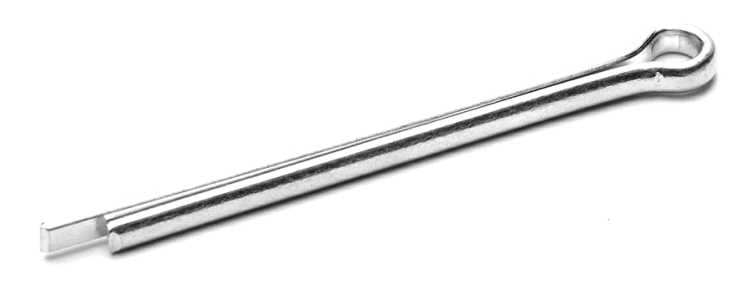

Hammerlock cotter pins are installed and locked in place with a hammer strike. CircleĬircle cotters, or cotter rings, conceal sharp edges internally to protect materials such as fabrics that may be susceptible to damage. This design allows for a more securely locked assembly. Styleīow tie cotter pins feature a loop on both ends of the pin, allowing for push or pull installation from either side of a hole. It offers the highest strength compared to other metals and elements, but is the least corrosion resistant. The most common material used in fasteners, this material is predominantly iron mixed with carbon.
COTTER PINS SERIES
There are over 150 grades of this material with the 304 and 316 series being the most common. The chromium forms a protective layer when exposed to oxygen, keeping the steel underneath from corroding. Cotter Pin Assortment Key Hair 555 Piece Shop Set 6 Sizes Axle Suspension Wheel. Hitch Clip Assortment Mechanical Hair R Cotter Pin Tractor Towing 100PCS/Box. This material is known for its corrosion resistance and has varying strengths depending on the amount of chromium and nickel alloy. 150 pcs Cotter Pins Assortment Kit Hitch Pin Clip Locking R Hairpin Mower Deck. Stainless SteelĪn iron based material with a minimum of 10.5% chromium. Used in locks, gears, doorknobs, plumbing, electrical applications and musical instruments. It has excellent cold working (forming at room temperature) properties. To use, place the cotter pin in the pre-drilled and the bulbous head will stop the pin. As an electroplated finish it is nonmagnetic and resists corrosion well. This cotter pin secures two items in place with the use of a common. This material has a distinctive bright golden coloring and is primarily used in aesthetic settings or in applications where low friction is necessary. This material has a general composition of 2/3 copper and 1/3 zinc. The corrosion resistance and ease of fabrication are why this grade is used in food industry machines, appliances, architectural trim and aquatic fasteners. The ASTM denotation for very similar grade is 304. It is comparable in strength to grade 2 materials, yet slightly weaker and easy to weld. A2-70Ī type of the most common stainless steel grade. The DIN/ISO denotation for a very similar grade is A4-70. It is used in more severe corrosive environments than 304 stainless steel, as such it is used in more industrial settings, like process chemicals, textiles, bleaches, salt water and rubber. It is on the low middle end of the grade scale.

They’re either a wedge or tapered pin that’s driven into a hole. The second most common stainless steel grade, this material is stronger than grade 2, slightly weaker than grade 5,or generally as strong as medium to low carbon steel. Cotter pins are typically used to prevent axial movement along a shaft. This finish should not be used in marine or high salt spray environments. Slightly less corrosion resistant than yellow zinc, it is a versatile finish that is best used indoors. It is a popular finish because of its protection, value, and ease of coating. The zinc protects the steel from corrosion and the chromate layer protects the zinc from degrading. It is an electroplated zinc layer covered with a chromate post-treatment. This finish, also know as zinc plating, zinc chromate or dichromate provides good corrosion resistance and is the standard for many hardware fasteners. This most basic finish can be used when protection is not an issue or indoors. This finish is susceptible to rusting and corrosion in exterior environments. Often the surface has been oiled which improves lubricity. Metric conversions in the table below are approximate.Nothing has been done to this bare metal surface to improve appearance or corrosion resistance, which is very low if the material is steel. Metric split pin sizes Nominal diameterĪmerican split pins start at 1⁄ 32 in and end at 3⁄ 4 in. The diameters of split pins are standardized. Types include standard, humped and clinch. This forces the shorter tine forward, spreading the pin. Hammer lock split pins are properly installed by striking the head with a hammer to secure the pin. To ease insertion into a hole the longer tine may be slightly curved to overlap the tip of the shorter tine or it is beveled. The extended prong type is popular because the difference in length of the two tines makes it easier to separate them. The most common type of split pin is the extended prong with a square cut, but extended prongs are available with all of the other types of ends. The length L of the split pin is defined as the distance from the end of the shortest tine to the point of the eyelet that contacts the hole. Types of ends available on split pins: Standard, extended prong, mitre end, bevel end and hammer lock.


 0 kommentar(er)
0 kommentar(er)
